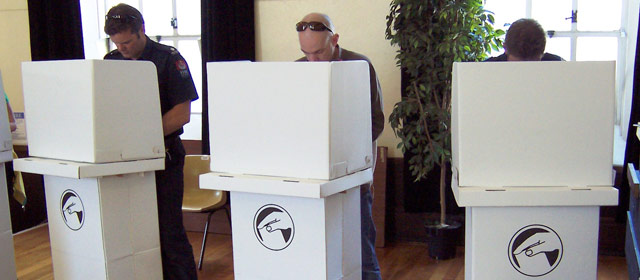Story summary
Electoral systems are the voting systems used to elect people to Parliament, local councils and other boards.
New Zealand’s first electoral systems
New Zealand’s government was based on the British model. Most electorates had only one member of Parliament (MP), but some had more than one. In those electorates voters had as many votes as there were vacancies. Multi-member districts were abolished in 1903.
First-past-the-post
Before 1996 the main voting system used in parliamentary elections was first-past-the-post. Under this system, the candidate who gets the most votes wins. It was usual for one party to win more than half of the seats in Parliament, so it could become the government. It was hard for minor parties to get into Parliament, because they had to win an electorate seat.
For a short time (1908–13) New Zealand had a two-round election system. If no one got at least half the votes in the first round, there was a run-off between the top two candidates.
Royal Commission on the Electoral System
Because of criticisms of first-past-the-post, including that it was biased against smaller parties, a royal commission was set up in 1985 to consider whether New Zealand should change its electoral system. The royal commission recommended that New Zealand should adopt a mixed-member proportional (MMP) electoral system and increase the number of MPs to 120.
Referendums
Two referendums were held for voters to say if they wanted to change the electoral system and, if so, what they wanted to change it to. The majority of people did want to change and chose MMP, which was introduced in 1996.
What is MMP?
Under MMP each voter has two votes – one for the electorate candidate they want to be their local MP, and the other for the political party they prefer (the party vote). The party gets seats in Parliament in proportion to its party votes. For example, if a party gets a third of the votes, it will get a third of the seats in Parliament.
Under MMP more small parties are represented. Until 2020 no party won half of all votes at an election. The large parties – National and Labour – had to go into coalition or make less formal agreements with one or more smaller parties to form a government. In 2020 Labour had the numbers to govern alone but chose to work with the Green Party, whose co-leaders became ministers.
2011 referendum
At the same time as the parliamentary election on 26 November 2011, a referendum was held to see if voters wanted to stay with MMP or change to a different electoral system. Nearly 58% voted to stay with MMP.
Local authority elections
In the 2000s four different electoral systems were used to elect mayors and councillors:
- first-past-the-post
- block voting, where voters have as many votes as there are vacancies
- preferential voting, where voters rank candidates in order of preference, and candidates need a majority to win
- single transferable voting, where voters rank candidates in order of preference, and candidates need a certain number of votes to win.





